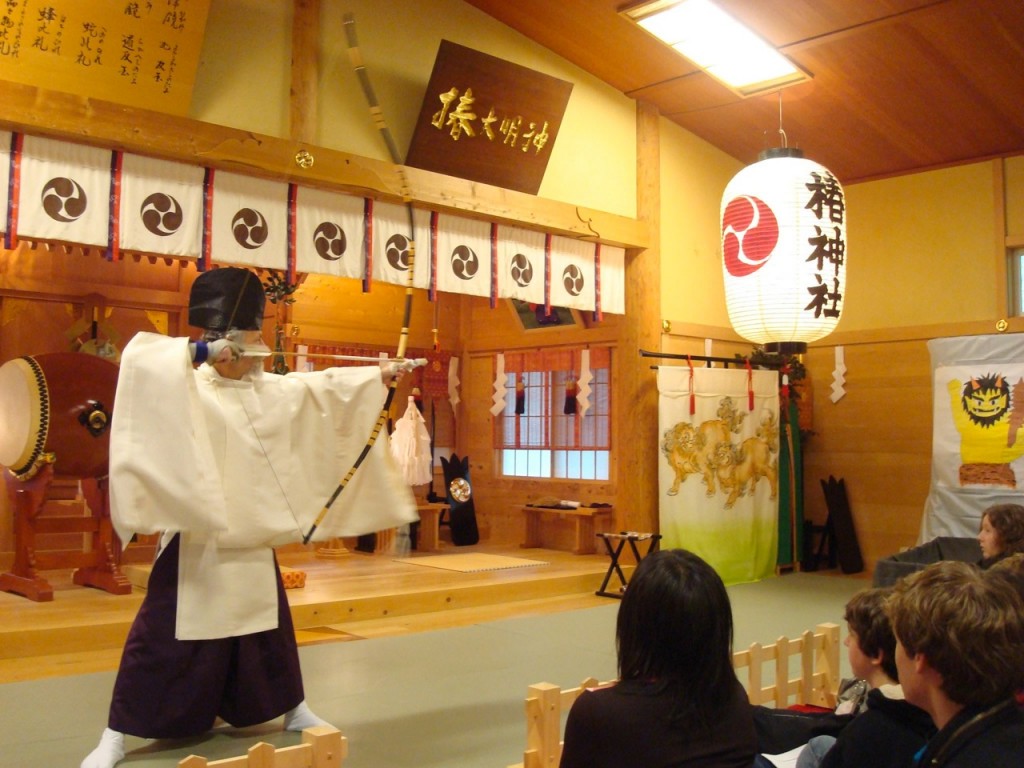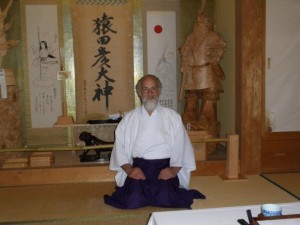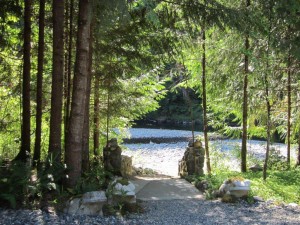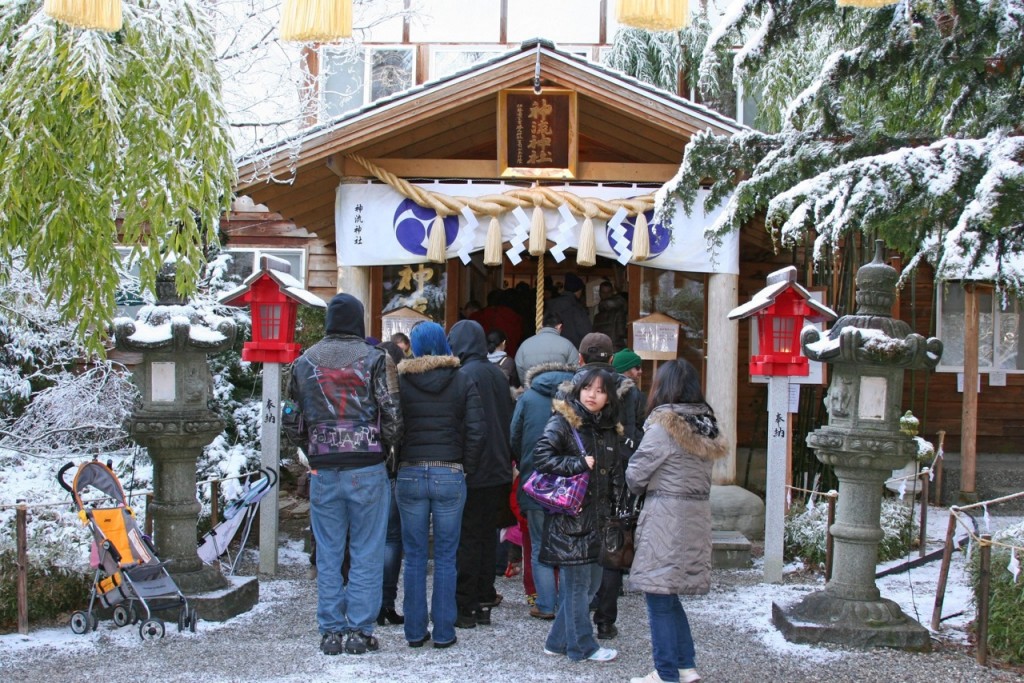
Rev. Barrish in discussion with aikido practitioners at the Tsubaki America shrine. A statue of Sarutahiko-no-O-Kami, principal deity of the shrine, can be seen in the background.
5) I believe the shrine is now financially independent. Where does the revenue come from?
Yes, we are what is called the “dokuritsu saisan” (financially independent branch). We remain very close organizationally and spiritually to Tsubaki Okami Yashiro and my teacher Yamamoto Yukiyasu Guji even though we operate independently financially. Of course operating the shrine, even of our size, is somewhat of a daunting task—we must pay taxes on much of our 23 acres as well as all supplies, utilities, maintenance, improvements, salaries, insurance etc…… shrine income comes in three main forms:
1) Gokitohryo (money donated to the Jinja at the time of conducting kito, or prayer ceremonies)
2) Juyohin (people wanting the Ofuda/ Kamidana, Omamori etc)
3) Sukeikai (members’ group who give donations and pay annual memberships)
Our parent shrine: Tsubaki Okami Yashiro in Mie is the well known Gokitoh Jinja or shrine where people go to receive Oharae and various types of ceremonies for families and companies and groups at all critical life junctures…..here at Tsubaki Grand Shrine of America we are also the Gokitoh Jinja, with Gokitohryo comprising probably around 80% of our support.

Firing the good luck arrow at the annual Setsubun festival
6) How easy or difficult would it be for others to follow in your path? And would you say there are possibilities for Shinto shrines elsewhere in the US?
Yes, the possibility space for more Jinja operating in North America and Europe certainly exists. To be honest it is not so very easy, as there is quite a bit involved — my opinion is that such a Jinja should be a close Bun-shya (branch shrine of one in Japan), or at least the kannushi (priest) should be trained completely—there have been cases of people thinking it must be easy to have a shrine and calling themselves Negi without any training, basically making it up…I don’t think this would be a good situation.
Interestingly enough, most of the same skills that would be needed to operate a Jinja in Japan as well as a whole different skill set would be needed to succeed in such an endeavor outside of Japan. Given the right circumstance I am very willing to assist such a project. Also I am hoping to find the right person to train here as next generation kannushi of this shrine…the combination of appropriate talents, multi-cultural comfort and desire to work very long hours for really low pay make it quite challenging to “fill the asagutsu” (shoes for the future).

7) Wicca paganism and shamanism have proved very popular in the West of late. Shinto by contrast seems tied to Japan. How do you see Shinto’s appeal in terms of non-Japanese and how can they practise despite the cultural isolation?
All human beings are equal under the sun because our lives all have their origin in divine solar Ki. Further, each human being receives the gift of having their lives sustained by the blessings of the sun. Ten-Chi Dai Shizen (Heaven, Earth and Great (divine) Nature) provides us with wisdom, strength and courage so we could harmonize positively with Daishizen-no-Meguri (ceaseless movements of Great Nature) and use our ingenuity to correct imbalance. The philosophy of harmonizing with nature and living according to the movements of the seasons serves as the foundation of Jinja Shinto.
This is quite simply the basis of our human existence. This is also the basis of Shinto – the way of progressing in harmony with divine nature. The path of gratitude to people and things that sustain your life, as well as the spirit of seeking cooperation is, I believe, a roadmap for human happiness and spiritual fulfillment.

Harmonising with nature at the Tsubaki America shrine
In my opinion Shinto, the genius of Japan, represents the basis of spirituality for human beings. Many people from diverse cultural backgrounds coming into contact with Shinto for the first time resonate completely with it and recognize that they have intuitively had the strong feelings of Shinto since their childhood time.
As for practicing in isolation, or away from communities —we are addressing this in two ways:
1) Our Tsubaki Kannagara Sukeikai (shrine members group) has people living all over the world (predominately in North America). We are encouraging the formation of Sukeikai Shibu, or branches in various locations, with the idea of meetings and group activities;
2) By utilizing social media…for instance Tsubaki America Jinja has a Facebook group https://www.facebook.com/groups/TsubakiShintoShrine/ that currently has around 1000 members—these members residing in various countries around the world and in various parts of North America are able to keep in contact, to stay connected with America Tsubaki Okami Yashiro, while learning about the seasonal observances and the life enhancing practices and attitudes of Jinja Shinto, as well as engaging in online dialogue with other members who may be on the opposite side of the globe.

Tsubaki Grand Shrine of America at New Year

Leave a Reply